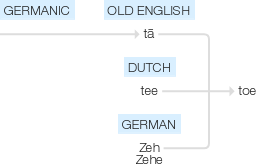Toe
Old English tā, of Germanic origin; related to Dutch tee and German Zeh, Zehe . Current senses of the verb date from the mid 19th century.
wiktionary
From Middle English to, from Old English tā, (Mercian) tāhe, from Proto-Germanic *taihwǭ (compare Dutch teen, German Zehe, Swedish tå), from *tīhwaną(“to show, announce”) (compare Old English teōn(“to accuse”), German zeihen(“to accuse, blame”)), from Proto-Indo-European *deyḱ-(“to show”) (compare Hittite[script needed](tekkuššāi), Latin dīcere(“to say”), digitus(“finger”), Ancient Greek δείκνυμι(deíknumi, “to point out, show”), Sanskrit दिदेष्टि(dídeṣṭi), दिशति(diśáti)).
etymonline
toe (n.)
Old English ta "toe" (plural tan), contraction of *tahe (Mercian tahæ), from Proto-Germanic *taihwō(n) (source also of Old Norse ta, Old Frisian tane, Middle Dutch te, Dutch teen (perhaps originally a plural), Old High German zecha, German Zehe "toe"). Perhaps originally meaning "fingers" as well (many PIE languages still use one word to mean both fingers and toes), and thus from PIE root *deik- "to show."
Þo stode hii I-armed fram heued to þe ton. [Robert of Gloucester, "Chronicle," c. 1300]
The old plural survived regionally into Middle English as tan, ton. To be on (one's) toes "alert, eager" is recorded from 1921. To step on (someone's) toes in the figurative sense "give offense" is from late 14c. Toe-hold "support for the toe of a boot in climbing" is from 1880.
toe (v.)
"touch or reach with the toes," 1813, from toe (n.). First recorded in expression toe the mark, which seems to be nautical in origin.
The chief mate ... marked a line on the deck, brought the two boys up to it, making them "toe the mark." [Richard H. Dana, "Two Years Before the Mast," 1840]
Related: Toed; toeing.
